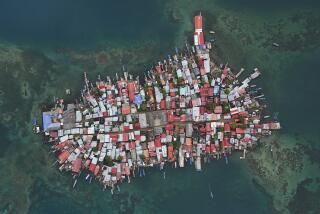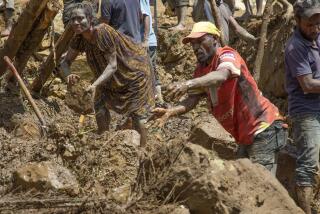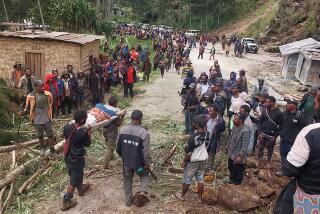Destination: Papua New Guinea : Pacific Embrace : African American tourists are greeted as family in this remote land
MADANG, Papua New Guinea â The children came first, running through the bushes in the darkness with lanterns and flashlights to guide their way. The women and the men followed, then the village headman.
Faces beaming, the villagers piled into our bus, which had stopped on the road leading to our lodge, 7,000 feet above the town where we had gone for dinner. They extended their hands, eager to get close to us. We were the first black people they were meeting from outside their island world of Papua New Guinea.
We were a group of two dozen African Americans taking a tour organized by Simmons African Museum in Brooklyn, N.Y., which runs cultural trips to Africa and South America, and were three days into our second South Pacific adventure. We had visited Fiji, Vanuatu, Western Samoa and Tonga two years before in our quest to make contact with some of the millions of black people living on the islands known as Melanesia, and with the people of the Polynesian archipelago.
With great excitement we had left the United States last July for Papua New Guinea, brushing off ribbing from friends and family about the countryâs past cannibal reputation: âMake sure you come back with your headsâ and âDonât end up in the pot.â
But nothing we had read or watched on television prepared us for the outpouring of affection we received as we traveled through the picturesque mountain, coastal and river villages of the land Portuguese explorers had christened Ilhas dos Papuas --âIsland of the Fuzzy Hairs.â
Everywhere we went, the people welcomed us like long-lost kin. Entire villages came out to greet our group, calling us âbrothers and sisters from the other side of the world.â Walking from the recesses of their lush villages, women embraced us, men grasped our hands in warm handshakes. Even the babies smiled as everyone regarded us with friendly curiosity.
All activity ceased and traffic halted in one town when we stopped at a bank to change dollars into kina, the local currency. Few had ever seen blacks other than themselves. Wantok , a village leader greeted us in pidgin English, his native language.
*
One of the few who spoke English, he explained what the word meant: âYou are family. We are one skin. Weâre the same.â
As we walked through an airport, a man told a female member of our group: âIâve seen you [African Americans] on MTV, but Iâve never seen you in person.â He rubbed her hands as if testing the fastness of her skin color.
We began our journey in Goroka, 5,000 feet above sea level and capital of the Eastern Highlands province. The people had lived there undiscovered until the 1930s, when Australian gold prospectors came upon them.
Our first excursion took us to a village nestled among banana, poinsettia and bamboo trees in the foothills, where the people live in circular houses with walls of woven mats and conical thatched roofs topped by tufted spires.
Young men who spoke English told us the village was 50,000 years old. They showed us their pet goats and offered us gifts of bows and arrows. Bilums , colorful knitted bags that women wear slung from their foreheads, were displayed for sale outside the houses. But the villagers were more interested in the braided hairstyles and long fingernails in our group than in their sales pitches.
That day we visited Asaro, home of the legendary mud men who once daubed their bodies with gray clay and wore mud masks over their heads to create ghostly apparitions that terrified their enemies. A local group re-enacted the mud menâs stealthy attacks.
The next day we left the Bird of Paradise Hotel, one of our four-star accommodations during the trip, and boarded charters for the flight to Mount Hagen, capital of PNGâs Western Highlands province.
When a bus transporting half of our group to the mountain lodge where we would stay got stuck in the mud on an unpaved road, people from the surrounding village swiftly pushed the bus out of the mud. It was these villagers who came to see the bus that night when we returned from dinner.
*
The nearly 4 million Papua New Guineans who gained their independence in 1975 live on the eastern half of what is the worldâs second largest island after Greenland. The island was the last inhabited place to be explored by Europeans. Dutch settlers called the island New Guinea, because it reminded them of East Africaâs Guinea.
Toward the end of the 19th Century, the country was divided among the British, the Germans and the Dutch. Australia took over the British section in 1905, and with independence, it became Papua New Guinea. The other half of the island, called Irian Jaya, is now part of Indonesia.
PNG includes 600 smaller islands, atolls, volcanoes and coral reefs of spectacular beauty, but tourism is still in its infancy. The people, reflecting 800 cultures and languages, are accustomed to seeing mostly Germans and Australians. Except for anthropologists, they encounter few Americans.
âWe think we are the only black people. We donât know about you,â one village chief told us through an interpreter. âWe are happy you are our brothers and sisters. The dress is different, but the color is still the same. When you go back to your country, talk about us. Say you saw some of your family in PNG.â
We left Mount Hagen for what was to be the high point of our trip. Light planes took us over the mountains to a grassy landing strip at Timbunke, a town on the bank of the Sepik River. Waiting speedboats ferried us to the Melanesian Discoverer, a luxury catamaran that would be our floating hotel as we visited more than a dozen villages of the Sepik region, described in tourist literature as âa wonderland of islands, river systems, swamplands, jungles and mountain ranges.â
One of the worldâs greatest waterways, the Sepik--called âthe river of artâ for the richness of the primitive art produced there--meanders from the highlands for 750 mostly navigable miles. In five days on the river we visited otherwise inaccessible villages, each of which had developed distinctive masks and other objects through which ancestral spirits become visible.
Before our boats touched the banks, villagers were at the waterâs edge in quiet greeting. We shook hands with the young men, the village elders, the children and women, who stood apart from the men, as custom dictates. The common language among us: smiles.
We had difficulty dividing our attention between the people and the array of artwork laid out for us to see: masks, some edged with mud embedded with shells and fringed with feathers or human hair; wicker figures of crocodiles; necklaces of pig tusks and dog teeth; drums with lizard-skin heads, and penis sheaths (because of objections from missionaries, these decorated cylindrical gourds are now worn only for ceremonies).
Entering the villages, we were struck by the beauty of the haus tambarans, large structures central to each village that are works of art themselves. They are off-limits to local women who mustnât see the sacred carvings representing the spirits stored there. But female tourists are admitted. In some villages, young men stay in an upper floor during warrior initiation, which includes scarring the skin.
*
Each stop afforded us a glimpse of village life. We saw roasted grubs for sale, and women making sago, a staple from the sago palm. The bark is cut away and the pith is pounded to the consistency of sawdust and steeped in water to leach out a starchy liquid to be made into pancakes.
At Palambei, a village by waterlily-covered lagoons, two men in the haus tambaran played a drum duet for us on a hollowed-out log. âGood to see you. Same color,â the headman told us, pointing to his skin. The village counselor, Aaron Malingi, said, âYour skin make me feel happy to see you, a people from a long way to visit my people, and I feel like you are part of my family.â
An initiated 17-year-old showed us swirling patterns cut with a razor around his nipples and across his back, the raised scars intended to mimic crocodile scales. The animal is venerated as a spirit but is also eaten.
At one village, a man jokingly offered one pig--a valuable item in the South Pacific--and 1,000 kina (about $500) for a petite member of our group.
In an act that symbolized the connection of our two worlds, four members of our group had our faces painted at one village. Artists used and ochers to replicate patterns from ancestral masks.
One morning as we prepared to leave the Melanesian Discoverer for an outing in an area of the Sepik known as Chambri Lakes, children standing in black dugout canoes poled them alongside the catamaran, offering us a ride to Kambaramba, their village on stilts, which we would be visiting that day. They brought with them satiny lotus flowers, lavender water hyacinths and baby alligators, but we piled into the speedboats instead.
Our PNG pilots skimmed across the expansive lake dotted with islands of floating vegetation, but slowed to avoid creating swells for the canoes that serve as taxis, trucks and bicycles on the Sepik. The pilots cut the roar of the motors, and we glided silently on canals flanked by prolific sago palms, startling white ibises, egrets and other waterfowl. Then the stillness was broken by marvelous bird song.
We cruised into Kambaramba, which is under five feet of water from January to May. Dogs, chickens, pigs and cats, as well as people, walk up overturned canoes to the elevated houses. The animals live on a front balcony when the water rises to the flooring.
The youngsters who had offered us rides reappeared, and with some trepidation we got into their canoes for a ride on the mirror-smooth water that is their front yard. Leaving the Sepik, we crossed the Bismarck Sea to Manam island, an active volcano. Swarms of children met us, some offering refreshing water coconuts. A 15-year-old school girl explained how they passed their days: âWe enjoy ourselves, cooking and working in the garden, swimming and dancing.â Adults stayed indoors, âbecause they are too old.â
Handbooks of Air Niugini, the national airline, describe Papua New Guinea as âa land where the earth is still at peace with the sky.â The people seem to take its beauty and tranquillity for granted, except those who could make comparisons. Peter Demi, a village headman whoâd visited the United States, commented, âI canât believe the difference. Many people in New York, San Diego and Los Angeles. I like live here. America is very, very big, too much. People never stop talking.â
Some locals fear that advancing Westernization and the movement of young people to the cities threaten their paradise. Stanley Lumbia, 28, an aspiring politician, noted, âAt this time weâre losing our traditions. The barter system is dying out. Trade needs money. The people who are educated can work for money.â He, too, had returned from the city to âstart to eliminate the influence of the European world.â
Another village chief, Ray Mato, echoed that sentiment. âUnder the Germans, all traditional things were banned,â he said. âWe tried to revive what was destroyed from the elders. Weâre now trying to keep it by making carvings, telling stories and doing dances and [living in] traditional houses.
âThis money problem has caused the people not to abide by traditional ways. Though we are happy here, weâre not as happy as before,â Mato said.
Some in our travel group asked Lumbia what other visitors had told them about African Americans. âThose of us who have been to school, we meet many Americans, but very few of them have good thoughts about African Americans,â he responded. âThey say you are troublemakers, aggressive. I saw you coming. I say our wantoks are coming, same color, friend.
âWe learned about your unfortunate history a long time ago and always felt sorry for you, how they went and got your ancestors and took them out. It could have been us,â he added.
Mato told us, âWe saw you in the films. We see that you are very good sports people. They donât show youâre doctors and lawyers.â
He also told us heâd read about the 19th-Century African American educator Booker T. Washington and was impressed. âYou people have determination. We donât agree with what they did to you. If theyâd come this way, we would have been slaves.â
Our tour leader, Stan Simmons, told them: âWeâre very interested in the culture of our people around the world. We want you to learn about us, because the [limited] information you got about us is misinformation.â
This same educational quest had taken the group to Fiji and other islands of the South Pacific, but none of our experiences had touched us as much as our contact with the Papua New Guineans. Our river voyage ended at Madang, a coastal town. We said our final goodbys during an impromptu stop at an elementary school, where the children and their teachers had abandoned their classes to crowd around us.
They sang their school song, their national anthem, âOh, Arise,â and a farewell serenade: âMay our love go with you when youâre gone.â Then they scattered flowers at our feet and handed us blossoms as we returned to our bus. A teacher said the children had read about African Americans but had never seen any before.
âWe touched the lives of these people as much as they touched us,â one of our group reflected at journeyâs end. âI donât think they will be the same.â Leaving PNG, like Papua New Guineans, we said goodby in pidgin: Lukim yu bihain .
(BEGIN TEXT OF INFOBOX / INFOGRAPHIC)
GUIDEBOOK
Crossing Cultures in Papua New Guinea
Getting there: There are no nonstop flights to Papua New Guinea from LAX, but connecting service to Port Moresby is available on Qantas, United, Cathay Pacific or Delta. Lowest round-trip, advance-purchase fares begin at about $1,500.
Tours: Tourism in Papua New Guinea is in its infancy, so most visitors travel via tours. Simmons African Museum in Brooklyn (telephone 718-230-0933), organized our tour at the request of the museumâs travel group. They have not yet scheduled another such tour.
A sampling of companies offering Papua New Guinea trips:
Adventure Express Travel, 650 5th St., Suite 505, San Francisco 94107; tel. (800) 443-0799.
Globas and Cosmos, 5301 S. Federal Circle, Littleton, CO 80123; tel. (800) 221-0090.
Melanesian Tourist Services, 302 W. Grand, Suite 10B, El Segundo 90245; tel. (310) 785-0370.
Swain Australia Tours, 2121 Avenue of the Stars, Suite 1270, Los Angeles 90067; tel. (800) 227-9246.
Travcoa, 2350 S.E. Bristol, Newport Beach 92660; tel. (800) 992-2003.
Visas: Visas are required and may be obtained from the Embassy of Papua New Guinea, 1615 New Hampshire Ave. N.W., Washington D.C. 20009; tel. (202) 745-3680.
For more information: Air Niugini, National Tourist Office, 5000 Birch St., Suite 3000, Newport Beach 92660; tel. (714) 752-5440.
More to Read
Sign up for The Wild
Weâll help you find the best places to hike, bike and run, as well as the perfect silent spots for meditation and yoga.
You may occasionally receive promotional content from the Los Angeles Times.






